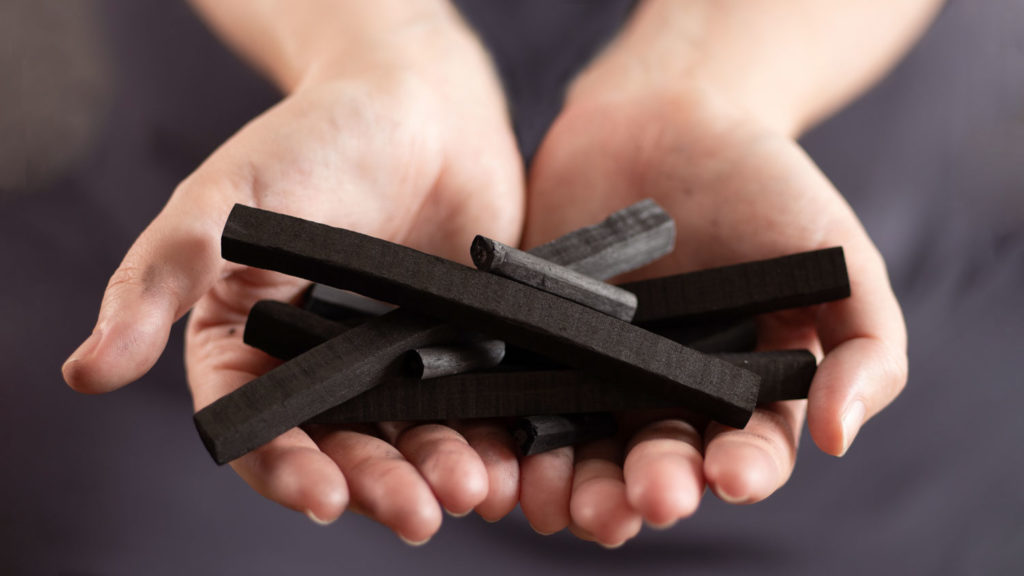
Charcoal is a popular drawing medium, thanks to its versatility and ease of use. But did you know that there are actually various charcoal products available for drawing?
When you go to an art store, you can buy different types of drawing charcoal. So what to choose?
What for example is the difference between willow charcoal and vine charcoal? Or what exactly is compressed charcoal? And is white charcoal actually charcoal at all?
In my online portrait class The Many Faces of Charcoal we’re going to use several different types of charcoal. So let’s have a closer look at what kinds of drawing charcoal are available and what they’re used for.
Willow and vine charcoal
 The most basic form of drawing charcoal is made of willow branches or sections of grape vine. By heating the wood in a kiln without any oxygen, the flammable gasses and water that are contained in the wood are removed. What remains are carbonized wooden sticks that can be used for drawing.
The most basic form of drawing charcoal is made of willow branches or sections of grape vine. By heating the wood in a kiln without any oxygen, the flammable gasses and water that are contained in the wood are removed. What remains are carbonized wooden sticks that can be used for drawing.
These willow or vine charcoal sticks are very brittle and powdery, because they don’t contain any binder. You just draw with the sticks on a piece of paper, and the powdery substance is being transferred onto the paper and kept into the fibers of the paper. There is no binding agent that ‘glues’ the charcoal onto the paper. This means that the charcoal can be easily smoothed out and erased, which is one of the main advantages of charcoal as a drawing medium. You can blend the charcoal using different tools, in order to create a range of tonal values and all kinds of beautiful textures.
The fact that willow and vine charcoal don’t contain any binder, however, also means that the drawing isn’t protected from any unwanted smudging. For this reason people sometimes use a fixative to bind the charcoal to the paper. The drawback however of using fixative is that it will also usually darken the drawing. Personally I avoid using fixative if I can. Instead, when I store my drawings I protect them with a sheet of glassine paper, or if I want to hang them somewhere I frame them behind glass.
What’s the difference between willow and vine charcoal? In general you can say that vine charcoal is a bit lighter (greyer) than willow charcoal. In my experience though, the difference is not that great. Also, it’s good to be aware that willow and vine charcoal are natural products and their properties (color, tonal value) can differ from brand to brand, and even from batch to batch. So it’s always good to try out different pieces from different brands and experiment with them to see what you like.
Charcoal powder
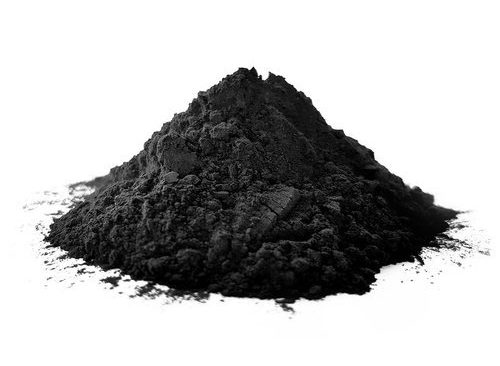 Charcoal powder is made from willow or vine charcoal that is grinded into a powder substance. You can apply it with a brush or all kinds of other tools, to create a beautiful soft look or to tone larger areas of your drawing.
Charcoal powder is made from willow or vine charcoal that is grinded into a powder substance. You can apply it with a brush or all kinds of other tools, to create a beautiful soft look or to tone larger areas of your drawing.
Charcoal powder can be bought ready-made in art stores, or you can make your own by grinding some willow or vine sticks using a mesh grate or kitchen grinder. It’s a good way to use up the tiny pieces of willow or vine charcoal that are left over. You can also make a little powder by rubbing your willow or charcoal sticks over a piece of sandpaper.
Compressed charcoal
Compressed charcoal are sticks made from charcoal powder and a binding agent – usually gum or wax. This mixture of charcoal powder and binder is then shaped into a mold, to create a stick form. You can use the stick like a type of crayon.
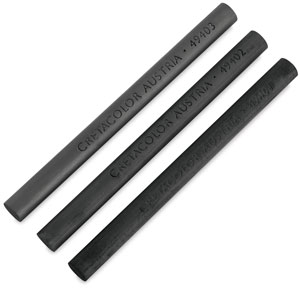 Compressed charcoal ranges from hard to soft, depending on the ratio of charcoal powder to binder. The more binder, the harder the compressed charcoal. And the degree of hardness in turn determines how light or dark the compressed charcoal is: the harder the charcoal stick, the less charcoal powder and hence the lighter the tonal value.
Compressed charcoal ranges from hard to soft, depending on the ratio of charcoal powder to binder. The more binder, the harder the compressed charcoal. And the degree of hardness in turn determines how light or dark the compressed charcoal is: the harder the charcoal stick, the less charcoal powder and hence the lighter the tonal value.
In most cases though, compressed charcoal is darker than regular willow and vine charcoal. The binder in the compressed charcoal also makes the stick harder and less prone to breaking than regular charcoal. You can use compressed charcoal on its side, to draw broader strokes, or use the tip to create lines.
Due to the binder in compressed charcoal, it adheres better to the paper than regular willow or vine charcoal. So that’s why it’s harder to smooth out or erase compressed charcoal than regular charcoal. This property has its pros and cons. You don’t really have to worry about accidentally smudging your drawing, because that doesn’t happen as easily. But it’s also harder to create soft gradations and transitions with this charcoal variety.
Charcoal pencils
Charcoal pencils are comparable to compressed charcoal, in the sense that most charcoal pencils are made from charcoal powder and a binder. And just like compressed charcoal they usually come in a range from hard to soft. The difference with compressed charcoal is that pencils are thinner, so that you can draw thinner lines with them.
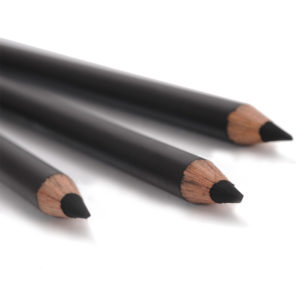 It’s best not to sharpen charcoal pencils with a regular pencil sharpener, but rather with a knife or blade. This way it’s easier not to break them. After sharpening the pencil with a knife, you can optionally create an even sharper tip by sanding it with sandpaper.
It’s best not to sharpen charcoal pencils with a regular pencil sharpener, but rather with a knife or blade. This way it’s easier not to break them. After sharpening the pencil with a knife, you can optionally create an even sharper tip by sanding it with sandpaper.
White charcoal
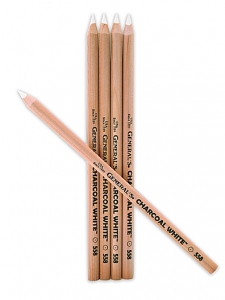 There are also pencils and compressed sticks available that are sold under the name of ‘white charcoal’. These pencils and sticks can be used just like regular charcoal pencils and compressed charcoal sticks, but they are white instead of black or grey.
There are also pencils and compressed sticks available that are sold under the name of ‘white charcoal’. These pencils and sticks can be used just like regular charcoal pencils and compressed charcoal sticks, but they are white instead of black or grey.
Calling these supplies ‘charcoal’ is a bit misleading, because they don’t contain any charcoal. Most often they are made with some kind of chalk. They are comparable with white pastel pencils and pastel crayons, but contrary to the pastels the white ‘charcoal’ supplies don’t contain any white pigment – just chalk.
In any case, these white charcoal pencils and sticks are called ‘white charcoal’, and since they can be very well combined with regular charcoal I am okay calling them charcoal. Even when they strictly aren’t… 😉
Tinted charcoal
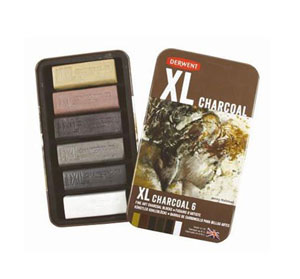 Lastly I want to mention tinted charcoal. These are just like regular charcoal pencils and compressed charcoal sticks, but the mix of charcoal powder and binder is tinted with a little bit of color pigment. The colors that they produce are fairly subtle and muted, since they are based on the dark grey and black tones of the regular charcoal powder. We are not going to use these tinted charcoal supplies in The Many Faces of Charcoal, but it’s certainly worth to give them a try.
Lastly I want to mention tinted charcoal. These are just like regular charcoal pencils and compressed charcoal sticks, but the mix of charcoal powder and binder is tinted with a little bit of color pigment. The colors that they produce are fairly subtle and muted, since they are based on the dark grey and black tones of the regular charcoal powder. We are not going to use these tinted charcoal supplies in The Many Faces of Charcoal, but it’s certainly worth to give them a try.
All about charcoal
If you would like to take an in-depth class on charcoal, then I recommend my charcoal portrait course The Many Faces of Charcoal.
In this comprehensive online class you'll learn to draw expressive faces using a variety of charcoal drawing techniques. We're going to make projects in different styles and work with various types of charcoal – from vine & willow charcoal, to compressed charcoal, charcoal pencil, charcoal powder, and more!
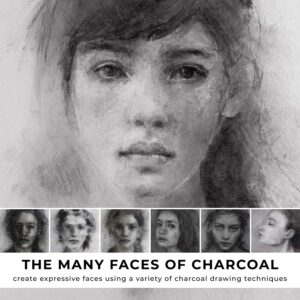


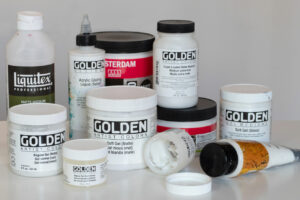
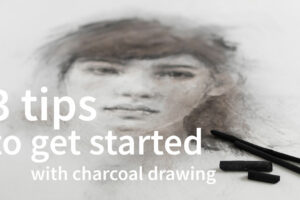

First at all, Thank you for your intresting article!
I would like (may I?) to get your attention to One type you didn’t mention and covered, Carbon pencils… the different between Charcoal to Carbon.
Although its not actually pure Charcoal, its close to Charcoal, and most of art supply stores/online stores refered it as kind of Charcoal.
I will be glad if you will cover it at your future articles (or maybe putting a little update to the existing article).
At the same opportunity I will also mention the graphite pencils mixed with carbon like the Staedtler Mars lumograph Black and The New (2021) Faber Castell Pitt Matt.
Thank you again for fascinating article!
Thank you for your suggestion Ronny! I indeed did not get into carbon, I only covered charcoal. Perhaps some time in the future. 🙂
Hi,
Is there any difference between a white charcoal pencil (chalk) and a tinted white charcoal pencil? How are the different from a practical perspective? Thanks.
Hi Chris, to be honest I can’t tell you that, because I have no experience with white tinted charcoal pencils. I only have used tinted black charcoal pencils. Thanks for stopping by! 🙂
Great information. Also some brands like Conté A Paris Pierre Noire and General’s Primo Euro pencils feel more like an oil pastel yet it’s oil and grease free. They use a special creamy formula.
Faber Castell Pitt pencils come in natural and compressed charcoal variants.
Carbon pencils are great if you’re used to graphite. This is a combination of graphite and charcoal. It lays down smoothly like graphite yet is dark like charcoal. Lyra extra dark 2B is a good option.
Thanks for your input Brandon! 🙂
Thanks for this very informative blog with so much to learn about charcoal! Have a great day, satay safe, Valerie
Thanks so much Valerie-Jael! Glad you found it informative! 🙂
Hi juna,
Your post is very interesting. I m a beginner and can say i prefer charcoal of saule, because it s more agradable to draw and authentic. I like too white chalk to make nuances, it s very beautiful.
I m exciting to read your next post and maybe some day follow your class.
Thanks for your comment Virginie! I believe that saule is willow, right? Yes, that’s a great type of charcoal to work with, I totally agree. So nice to hear your thoughts and it would be awesome to have you in class some day! Happy drawing! 🙂
i love making my own charcoal powder. I make it using the left over coals from our fire in winter. I also have tried wallpaper paste as a binder(methycellulose) to make sticks and want to try acacia gum from the wattle trees. I am a bit of a nature freak, lol.
Oh I love that, Vicki! And charcoal is perfect for that, since it’s already a natural product. How awesome!
Thank you, that was interesting. I’ve always wondered what the differences are and now I know!
Great to hear that, Sheila! Thanks for stopping by! 🙂
Very helpful introduction to charcoal types, thank you, Juna. I’ve been gradually learning about charcoal over the last few months: asking at my local art shop I often found they couldn’t give me much advice so I’ve picked things up a little through classes and experimenting as I went along. It’s great to have it presented so clearly here and all in the one place, though. I love your work and I am very much looking forward to the course. The bonus, mini lesson was excellent and I learned a lot just from that alone.
I’m so happy to hear that! You’re going to love the class. There’s so much you can do with this wonderful drawing medium! I can’t wait to get started with all of you. Enjoy the class! 🙂
Thanks for your information, it is very helpful to understand how to achieve the tonal value.
One mistake that I often made is make strong lines, with a regular pressure and then, they become difficult to erase or blur. It is something I have to practice.
Glad you found it useful Ivannia! Yes, it’s easier (at least for me!) to start drawing with really light lines, and then slowly build up the darker values. Exactly for the reasons you mention. Good observation! And if you just keep practicing this skill, it will come more easily. 🙂
I must say that I am pretty new to charcoal but I prefer the pencil and compressed. Thank you for your I sight and I am looking forward to your clasd
Yes, pencils and compressed charcoal are great to work with! In my class you will also get to use the other types of charcoal, and to combine them in one drawing. Thanks so much for your comment! 🙂
That’s so helpful, thank you Juna. Really looking forward to the course. ☺
Great you found the info helpful Lynda! And I can’t wait to get started with the class! 🙂
Hi Jana
I’m in .. I try to do it in Time with The online Workshop. Otherwise later on, we have live Time Access, Great.
One question, Do you give also Feedback, like in The “Soul” Workshop?
Thank you so much
Marianna (Danslaterre)
Hi Juna
Great, i’m in, I try to Do it in The live Workshop.
Otherwise we have live Time access. Thank you for these opportunity.
One question, do you give also feedback, like in the “Soul” workshop?
We see us in the course, of corse.
Bye
Marianna
Wonderful to have you in class again, Marianna! And yes, you can totally do it in your own pace, because you do have lifetime access. So no hurry! 🙂 Regarding the feedback: I’m not giving feedback like in Drawing in the Soul, but I will be available for any questions you might have.
Thanks you always explain things so clearly.I have been wondering what compressed charcoal is and after reading this I find I have some . I don’t really like it as much as the willow.
Thank you so much for your comment Glen! I’m really happy to hear that! Yes, it can be quite confusing, all those different types of charcoal. It was for me too. And I also do understand what you say about using compressed charcoal compared to willow charcoal. However, I now know that they all have their use, and I’m sure that after you have done The Many Faces of Charcoal you will find that too! 🙂